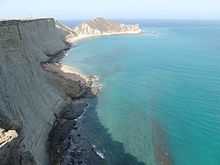Balochistan, Pakistan
| Balochistan | |||
|---|---|---|---|
| Province | |||
| |||
.svg.png) | |||
| Coordinates: 30°07′N 67°01′E / 30.12°N 67.01°ECoordinates: 30°07′N 67°01′E / 30.12°N 67.01°E | |||
| Country |
| ||
| Established | 1 July 1970 | ||
| Provincial Capital | Quetta | ||
| Largest city | Quetta | ||
| Government | |||
| • Type | Province | ||
| • Body | Provincial Assembly | ||
| • Governor | Muhammad Khan Achakzai | ||
| • Chief Minister | Abdul Malik Baloch | ||
| Area | |||
| • Total | 347,190 km2 (134,050 sq mi) | ||
| Population (2011) | |||
| • Total | 7,914,000 | ||
| Time zone | PKT (UTC+5) | ||
| Main Language(s) | Urdu (National), Balochi, Pashto, Brahui | ||
| Provincial Assembly seats | 65 | ||
| Districts | 32 | ||
| Union Councils | 86 | ||
| Website | www.balochistan.gov.pk | ||
Balochistan (Balochi, Pashto, Urdu: بلوچِستان, Balōčistān, pronounced [bəloːt͡ʃɪst̪ɑːn]), is a province of southwestern Pakistan. It spreads primarily along the eastern part of the geographic region of Balochistan. It is the largest of Pakistan's four administrative provinces in terms of area, constituting approximately 44% of the country's total land mass, and the smallest in terms of population, being home to less than 5% of the country's population. Balochistan province is bordered by Afghanistan to the north and north-west, Iran to the south-west, the Arabian Sea to the south, Punjab and Sindh to the east, and Khyber Pakhtunkhwa and Federally Administered Tribal Areas to the north-east. Quetta is the capital and largest city of Balochistan.
The main ethnic groups in the province are Baloch, Pashtuns and Brahuis, and there are relatively smaller communities of Iranians, Hazaras, Sindhis and other settlers, including Punjabis, Uzbeks, and Turkmens. The name Balochistan means "the land of the Baloch" in many regional languages.
History
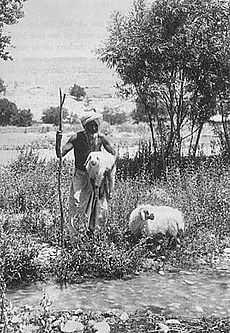
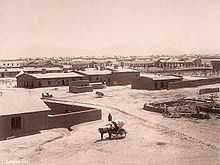
Early history
Balochistan occupies the eastern portion of the Iranian Plateau, the site of the earliest known farming settlements in the pre-Indus Valley Civilization era, the earliest of which was Mehrgarh dated at 7000 BC. Balochistan was one of the first places Zoroaster travelled to from Bactria in search of converts to his religion. Some of the first proselytes of his religion lived here before Zoroastrianism spread into western portions of the Iranian plateau.[citation needed] Makran and other parts of Balochistan used to be parts of Maurya, Kushan, Guptas, partly of empire of Harsha Vardhana and other dynasties of northern India before advent of Turk-Afghans.
Like other middle eastern ethnic groups, the Baloch claim Arabian extraction and assert that they are descended from Amir Hamza, a paternal uncle of the Islamic Prophet Muhammad and from a fairy (Pari). They consistently place their first settlement in Aleppo, where they remained until they sided with the sons of Ali, took part in the Battle of Karbala and were expelled by Yazid, the second Umayyad Caliph, in 680 A.D. They went to Kerman, and eventually to Sistan where they were hospitably received by Shams-ud-Din, ruler of that country. According to Mansel Longworth Dames there was a Shams-ud-Din, an independent Malik of Sistan, who died in 1164 A.D. (559 A.H.), almost 500 years after the Baloch migration from Aleppo. Shams-ud-Din claimed descent from the Saffarids of Persia . His successor, Badr-ud-Din, appears to be unknown to history, demanded a bride from each of the 44 bolaks or clans of the Baloch. But the Baloch race had never yet been tribute in this form to any ruler, and they sent 44 boys dressed in girls' clothes and fled before the deception could be discovered. Badr-ud-Din sent the boys back but pursued the Baloch, who had fled south-eastwards into Kech-Makran where they defeated him. During this period Mir Jalal Khan, son of Mir Jiand Khan, was the ruler of the Baloch. He left four sons, Rind, Lashar, Hooth, and Korai, and a daughter Jato, who married his nephew Murad. These five are the eponymous founders of the five great divisions of the tribe, the Rinds, Lasharis, Hooths, Korais, and Jatois.[1]
However, another theory says that the Baloch have Medes origin,.[2] They are a Kurdish group that has absorbed some Dravidian genes and cultural traits, primarily from Brahui people.[citation needed] The northern point of Balochistan known in Pashto as Dzaranga was known as Drangiana to the Greeks and came to be known to the Persians as Saka. The Persian epic of Shahnama does record the Baloch in the Qazvin-Zanjan region of old Iran in the 6th century AD, when they were engaged in battle by the Persian king Chosroes I Anoshirvan, The Shahnama also records its heroes, Rustom and Sohrab, as being Saka and not Persians, making Sistan or the old Sakistan their origin. With time, Baloch tribes linguistically absorbed all the local people in Makran, southern Sistan and the Brahui country, becoming a sizeable group to rival in size the other Iranic group in the region .[citation needed]
In the 7th century, the region was divided into two parts; the south was part of the Kermān Province of the Persian Empire and the north became part of the Persian province Sistan. In early 644, the Islamic Caliph Umar sent Suhail ibn Adi from Busra to conquer the Kerman region of Iran. He was then made governor of that region. From Kerman, he conquered the western Balochistan region, near the Persian frontiers.[3] In the same year, south-western Balochistan was conquered during the campaign in Sistan. In 652 during the reign of Caliph Uthman, Balochistan was reconquered during the counter-revolt in Kerman under the command of Majasha Ibn Masood. This was the first time western Balochistan was directly controlled by the Caliphate and paid taxes on agriculture.[4] Western Balochistan was included in the dominion of Kerman. In 654, Abdulrehman ibn Samrah, governor of Sistan, sent an Islamic army to crush a revolt in Zaranj, which is now in southern Afghanistan. After conquering Zaranj, a column of the army pushed north, conquering Kabul and Ghazni, in the Hindu Kush mountain range, while another column moved through Quetta District in north-western Balochistan and conquered the area up to the ancient cities of Dawar and Qandabil (Bolan).[5] By 654, the whole of what is now Balochistan was controlled by the Rashidun Caliphate, except for the well-defended mountain town of QaiQan which is now Kalat. However, this town was later conquered during the reign of Caliph Ali.[6] Abdulrehman ibn Samrah made Zaranj his provincial capital and remained governor of these conquered areas from 654 to 656, until Uthman was murdered.
During the Caliphate of Ali, a region of Balochistan, Makran again revolted. Due to civil war in the Rashidun Caliphate, Ali was unable to deal with these areas until 660, when he sent a large force, under the command of Haris ibn Marah Abdi, towards Makran and Sind. Haris ibn Marah Abdi arrived in Makran and conquered it by force, and then moved northward to north-eastern Balochistan and reconquered Qandabil (Bolan). Finally, he moved south and conquered Kalat after a fierce battle.[7] In 663, during the reign of Umayyad Caliph Muawiyah I, Muslims lost control of north-eastern Balochistan and Kalat when Haris ibn Marah and large part of his army died in battle against a revolt in Kalat.[8] Muslim forces later regained control of the area during the Umayyad reign. It also remained a part of the Abbasid Caliphate.
In the 15th century, Mir Chakar Khan Rind became the first king of Balochistan, after which the region was dominated by the Timurids, who controlled Persia and Afghanistan. The Mughal Empire also controlled some parts of the area. When Nadir Shah won the allegiance of the rulers of Balochistan, he ceded Kalhora, one of the Sindh territories of Sibi-Kachi to the Khan of Kalat.[9][10][11] Ahmad Shah Durrani, successor of Nadir Shah and founder of the Afghan Empire, also won the allegiance of that area's rulers. Most of the area would eventually revert to local Baloch control.
British rule
During the period of the British Raj, there were four Princely States in Balochistan: Makran, Kharan, Las Bela and Kalat. In 1876, Sir Robert Sandeman made a treaty with the Khan of Kalat and brought his territories, including Kharan, Makran, and Las Bela, under the British suzerainty. After the Second Afghan War was ended by the Treaty of Gandamak in May 1879, the Afghan Emir ceded the districts of Quetta, Pishin, Harnai, Sibi and Thal Chotiali to the British. In 1883, the British took control of the Bolan Pass, south-east of Quetta, from the Khan of Kalat. In 1887, some areas of Balochistan were declared British territory. In 1893, Sir Mortimer Durand negotiated an agreement with the Amir of Afghanistan, Abdur Rahman Khan, to fix the Durand Line running from Chitral to Balochistan as the boundary between the Emirate of Afghanistan and British-controlled areas. Two devastating earthquakes occurred in Balochistan during British colonial rule: the 1935 Balochistan Earthquake, which devastated Quetta, and the 1945 Balochistan Earthquake with its epicentre in the Makran region.[citation needed]
After independence
In August 1947, the Chief Commissioner's Province of Balochistan immediately became part of Pakistan. Followed by the princely states of Makran, Kharan, Las Bela and Khanate of Kalat who decided to accede to Pakistan in March 1948. The Khan of Kalat agreed to join Pakistan under the condition that defence, currency, foreign office, and finance would be controlled by the federal government but that the province would remain otherwise autonomous. The four princely states together formed the Balochistan States Union in October 1952. The enclave of Gwadar was excluded from this as it was still part of the Sultanate of Oman.
In October 1955, formation of one unit resulted in the Balochistan States Union and the Chief Commissioner's Province of Balochistan being merged together with all the remaining provinces and princely states in other parts of Pakistan to form the province of West Pakistan. The enclave of Gwadar was purchased from Oman in October 1958 and was also merged with West Pakistan. The province was officially dissolved in 1970 and the former Balochistan States Union, former Chief Commissioner's Province of Balochistan were combined to form the new province of Balochistan. The government of Pakistan later decided to incorprate Gwadar in to Balochistan in 1977 thus expanding the Balochistan province to its current form.
Geography

Balochistan is situated in the southwest of Pakistan and covers an area of 347,190 square kilometres (134,050 sq mi). It is Pakistan's largest province by area constituting 44% of Pakistan's total land mass. The province is bordered by Afghanistan to the north and north-west, Iran to the south-west, Punjab and Sindh, and Khyber Pakhtunkhwa and the Federally Administered Tribal Areas to the north-east. To the south lies the Arabian Sea. Balochistan is located on the south-eastern part of the Iranian plateau. It borders the geopolitical regions of the Middle East and Southwest Asia, Central Asia and South Asia. Balochistan lies at the mouth of the Strait of Hormuz and provides the shortest route from seaports to Central Asia. Its geographical location has placed the otherwise desolate region in the scopes of competing global interests like Afghanistan for all of recorded history.
The capital city Quetta is located in a densely populated portion of the Sulaiman Mountains in the north-east of the province. It is situated in a river valley near the Bolan Pass which has been used as the route of choice from the coast to Central Asia, entering through Afghanistan's Kandahar region. The British and other historic empires have crossed the region to invade Afghanistan by this route.[12]
Balochistan is rich in exhaustible and renewable resources; it is the second major supplier of natural gas in Pakistan. The province's renewable and human resource potential has not been systematically measured nor exploited due to pressures from within and without Pakistan. Local inhabitants have chosen to live in towns and have relied on sustainable water sources for thousands of years.
Climate
The climate of the upper highlands is characterised by very cold winters and hot summers.[13] In the lower highlands, winters vary from extremely cold in northern districts Ziarat, Quetta, |Kalat, Muslim Baagh and Khanozai to milder conditions closer to the Makran coast. Winters are mild on the plains, where temperature never falling below freezing point. Summers are hot and dry, especially in the arid zones of Chaghai and Kharan districts. The plains are also very hot in summer, with temperatures reaching 50 °C (122 °F).The record highest temperature, 53 °C (127 °F), was recorded in Sibi on 26 May 2010,[14] exceeding the previous record, 52 °C (126 °F). Other hot areas includes, Turbat, and Dalbandin. The desert climate is characterised by hot and very arid conditions. Occasionally strong windstorms make these areas very inhospitable.
Economy
The economy of Balochistan is largely based upon the production of natural gas, coal and other minerals. Other important economic sectors include fisheries, mining, manufacturing industries, trade and other services being rendered by public and private sector organisations. Tourism remains limited but has increased due to the exotic appeal of the province. Limited farming in the east and fishing along the Arabian Sea coastline provide income and sustenance for the local population. Due to the tribal lifestyle of many Baloch and Brahui people, animal husbandry and trading bazaars found throughout the province are important.
Though the province remains largely underdeveloped, several major development projects, including the construction of a new deep sea port at the strategically important town of Gwadar,[15] are in progress in Balochistan. The port is projected to be the hub of an energy and trade corridor to and from China and the Central Asian republics. The Mirani Dam on the Dasht River, 50 kilometres (31 mi) west of Turbat in the Makran Division, is being built to provide water to expand agricultural land use by 35,000 km2 (14,000 sq mi) where it would otherwise be unsustainable.[16]
Natural resource extraction
Balochistan's share of Pakistan's national income has historically ranged between 3.7% to 4.9%.[17] Since 1972, Balochistan's gross income has grown in size by 2.7 times.[18] Outside Quetta, the resource extraction infrastructure of the province is gradually developing but still lags far behind other parts of Pakistan.
There is Chinese involvement in the nearby Saindak gold and copper mining project where deposits exist in the Chagai District in Reko Diq area. The main license is held jointly by the Government of Balochistan (25%), the rest by foreign interests Antofagasta Minerals (37.5%) and Barrick Gold (37.5%). These deposits are comparable in size to those located in Sarcheshmeh, Iran and Escondida, Chile, which are the second and the third largest known deposits of copper in the world.[citation needed] The multinational mining companies BHP Billiton and Tethyan entered into a joint venture with the Balochistan government to extract these deposits. The potential annual copper production has been estimated to be 900,000 to 2.2 million tons.[citation needed] The deposits seem to be largely of porphyry rock nature.[citation needed] The agreements for royalty rights and ownership of these resources were reached during a period of unprecedented natural disasters, economic, social, political, and cultural unrest in Pakistan. The negotiations were widely considered to be insufficiently transparent.[19]
Government
| Provincial animal | Camel | 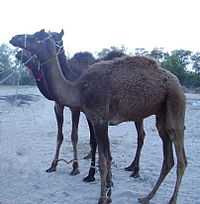 |
|---|---|---|
| Provincial bird | Houbara bustard |  |
| Provincial tree | Date Palm | |
| Provincial flower | Ephedra distachya |  |
In common with the other provinces of Pakistan, Balochistan has a parliamentary form of government. The ceremonial head of the province is the Governor, who is appointed by the President of Pakistan on the advice of the provincial Chief Minister. The Chief Minister, the province's chief executive, is normally the leader of the largest political party or alliance of parties in the provincial assembly.
The unicameral Provincial Assembly of Balochistan comprises 65 seats of which 4% are reserved for non-Muslims and 16% exclusively for women. The judicial branch of government is carried out by the Balochistan High Court, which is based in Quetta and headed by a Chief Justice. For administrative purposes, the province is subdivided into 31 districts:[20]
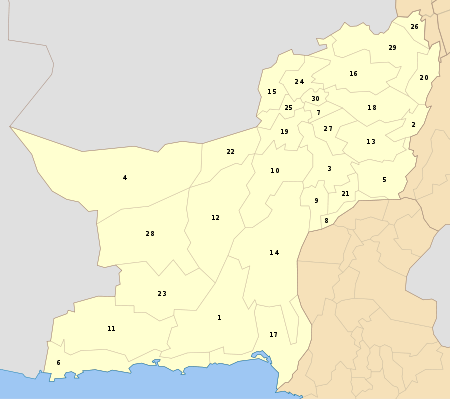 |
Demographics
| Historical populations | ||
|---|---|---|
| Census | Population | Urban |
|
| ||
| 1951 | 1,167,167 | 12.38% |
| 1961 | 1,353,484 | 16.87% |
| 1972 | 2,428,678 | 16.45% |
| 1981 | 4,332,376 | 15.62% |
| 1998 | 6,565,885 | 23.89% |
Balochistan's population density is very low due to the mountainous terrain and scarcity of water. In March 2012, preliminary census figures showed that the population of Balochistan had reached 13,162,222, not including the districts of Khuzdar, Kech and Panjgur, compared to 5,501,164 in 1998,[21] representing approximately 5% of Pakistan's total population.[22] Official estimates of Balochistan's population grew from approximately 7.45 million in 2003 to 7.8 million in 2005.[23]
Ethnolinguistic groups

According to the Ethnologue, households whose primary language is Makrani constitutes 13%, Rukhshani 10%, and Sulemani 7% of the population. Pashto is also spoken by around 39% of the population and 13% of households speak Brahui. Rest of 18% population speaks various languages including Lasi, Urdu, Punjabi, Hazargi, Sindhi, Saraiki, Dehvari, Persion, Tajik, Hindko, Uzbik, and Hindki.[24]
Rukhshani is spoken in the sparsely populated west, Sulemani is spoken by the tribal east mainly by Murree Bughtis, and Makrani is mostly spoken in south coastal areas. In addition, the coastal region of Makran is home to communities such as the Siddi and Med, who speak distinct ethnic dialects. Brahui is spoken in the central Baluchistan and Pashto is mainly spoken in the north and north-west including Quetta. In Barkhan and Musakhel districts bordering Punjab, Pashto is the local language. There are also a number of speakers of Hazaragi Persian, Urdu, and Punjabi in the capital Quetta and other areas of Baluchistan. Farsi Persian is also spoken. Sindhi is spoken in the south-east. The Jamot tribes of Sibi Naseerabad and Kachhi region mainly speak Jadgali (Sindhi). The Kalat and Mastung areas speak Brahui. In the Lasbela District, the majority of the population speaks Lasi.[25]
The 2005 census of Afghans in Pakistan showed that a total of 769,268[26] Afghan refugees were temporarily staying in Balochistan. However, this number is likely to be reduced in 2013 after the repatriation of the refugees to Afghanistan.
Gallery
-

Princess of Hope along the N10
-

Quetta Railway Station
-

Koh-i-Chiltan in winter
See also
- Pārata Dynasty
- Aprāca Dynasty
- Balochistan
- Tourism in Balochistan, Pakistan
- Baloch Nationalism
References
- ↑ Encyclopaedia Of Untouchables Ancient, Medieval And Modern By Raj Kumar, page no. 337|http://books.google.com/books?id=e8o5HyC0-FUC
- ↑ M. Longworth Dames, Balochi Folklore, Folklore, Vol. 13, No. 3 (29 Sep. 1902), pp. 252–274
- ↑ Ibn Aseer, Vol. 3, p. 17
- ↑ Futuh al-Buldan, p. 384 incomplete citation, needs edition statement to identify the page
- ↑ Tabqat ibn Saad, Vol. 8, p. 471
- ↑ Futuh al-Buldan, p. 386 incomplete citation, needs edition statement to identify the page
- ↑ Rashidun Caliphate and Hind, by Qazi Azher Mubarek Puri, published by Takhliqat, Lahore Pakistan
- ↑ Tarikh al Khulfa, Vol. 1, pp. 214–215, 229
- ↑ Dawn.com
- ↑ Iranica.com
- ↑ Panhwar.org
- ↑ Bolan Pass – Encyclopædia Britannica Eleventh Edition
- ↑ Weiss, Anita M. and Mughal, Muhammad Aurang Zeb. 2012. Pakistan. Louis Kotzé and Stephen Morse (eds), Berkshire Encyclopedia of Sustainability, Vol. 9. Great Barrington, MA: Berkshire, pp. 236-240.
- ↑ Pakmet.com.pk
- ↑ "Gawader". Pakistan Board of Investment. Archived from the original on 2006-10-02. Retrieved 2006-11-19.
- ↑ "Mirani Dam Project". National Engineering Services Pakistan. Retrieved 19 November 2006.
- ↑ "Provincial Accounts of Pakistan: Methodology and Estimates 1973–2000".
- ↑ Siterresources.worldbank.org
- ↑ "$260 billion gold mines going for a song, behind closed doors". Thenews.com.pk. Retrieved 2012-08-14.
- ↑ "Districts". Government of Balochistan. Archived from the original on 7 August 2010. Retrieved 13 August 2010.
- ↑ "Population shoots up by 47 percent since 1998". Thenews.com.pk. 29 March 2012. Retrieved 14 August 2012.
- ↑ "Population, Area and Density by Region/Province" (PDF). Federal Bureau of Statistics, Government of Pakistan. 1998. Retrieved 20 July 2009 .
- ↑ Pakistan Balochistan Economic Report: From Periphery to Core (In Two Volumes) – Volume II: Full Report. The World Bank. May 2008. "The Balochistan population totalled 4.5 million in 1981/82 and 7.8 million in 2004/05..." "NIPS estimates that Balochistan's population growth will slow down to 1.3 percent by 2025..."
- ↑ "Percentage Distribution of Households by Language Usually Spoken and Region/Province, 1998 Census". Pakistan Statistical Year Book 2008. Federal Bureau of Statistics – Government of Pakistan. Retrieved 19 December 2009 .
- ↑ "Balochistān". Encyclopædia Britannica. 2009. Retrieved 15 December 2009.
- ↑ Afghanistan Research and Evaluation Unit (AREU), Afghans in Quetta. Settlements, Livelihoods, Support Networks and Cross-Border Linkages, January 2006, available at: http://www.unhcr.org/refworld/docid/47c3f3c412.html [accessed 7 January 2013]
Further reading
- Johnson, E.A. (1999). Lithofacies, depositional environments, and regional stratigraphy of the lower Eocene Ghazij Formation, Balochistan, Pakistan. U.S. Geological Survey Professional Paper 1599. Washington, D.C.: U.S. Geological Survey.
External links
| Find more about Balochistan, Pakistan at Wikipedia's sister projects | |
| |
Definitions and translations from Wiktionary |
| |
Media from Commons |
| |
Quotations from Wikiquote |
| |
Source texts from Wikisource |
| |
Textbooks from Wikibooks |
| |
Travel guide from Wikivoyage |
| |
Learning resources from Wikiversity |
- Official website
- Guide to Balochistan
- Balochistan on the Open Directory Project
| |||||||||||||||||||||||
| |||||||||||||||||
| ||||||||||


